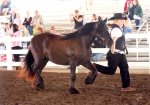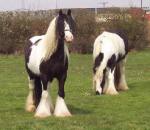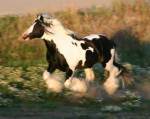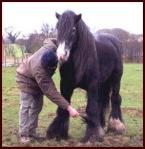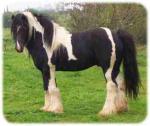http://ideas.time.com/2011/12/28/the-case-for-eating-horse-meat/
The above link has some interesting info, especially if you have the stamina to read through the responses!
I want to reiterate that my stand on horse slaughter comes from the viewpoint that I believe it’s inclusion as an industry in the US has value in a “green” world. It should have merit as part of the cycle of life and making all animals useful. I don’t believe that euthanasia is a realistic alternative for the majority of horses out there; I don’t expect people to start eating horse meat but also I don’t think the average horse owner keeps a horse all throughout it’s life and plans for how it will eventually end it’s life. Circumstances are not stable throughout life for most people, incomes fluctuate and why should everyone be expected to spend at least several hundred dollars to dispose of a horse when in fact, EPA does not want you to have to worry about how a horse will be disposed of?….but that info is for another day.
Here’s a copy of an article that I have edited from another source, also discussing horse meat facts:
Four reasons to eat horse meat
From its surprisingly good nutritional values to the arbitrary reasons it was considered “taboo” in the first place, this list gives you a rundown on horse meat
1. Horse Meat is Taboo Thru Tradition, Not Fact
Horse meat has been taboo in the U.S. and U.K. at various points during their history, but they are some of the only countries to do so. In large part, horses are not seen as meat products simply because they have not been used that way. Horse was commonly eaten throughout pioneering U.S. history and was greatly consumed by all during the years of WWII when there was also an overpopulation of horses left from their discontinued use on farms.
In countries like France, Italy, Belgium, Japan, Spain, horse meat consumption has been widespread for centuries, and is therefore considered a staple or a delicacy.
In fact, one reason why it’s so strange to consider horse flesh as meat may be because the English language has no word to describe it. While pig meat has four terms (pork, bacon, ham and gammon), two for cow (beef, veal) and three for sheep (lamb, mutton and hogget), horse has nothing except the rarely used euphemism “cheval meat” (“cheval” is French for “horse”).
When it comes down to it, everyone who’s a meat eater must ask themselves: why is it acceptable to eat very useful animals like cows (who provide dairy and can be work animals) or intelligent animals like pigs (who are very similar in bone structure and musculature to humans), but somehow wrong to eat horses? There are lots of people in the world who eat meat protein from innumerable sources; guinna pigs, rabbit, beaver, squirrel……not to mention bear and pronghorn, elk, etc. and birds/fish.
2. Horse Meat (and Slaughter) Has Been Widespread in U.S. Before Now
Even if one doesn’t count the illegal horse slaughter that’s happened in the four years since the practice was banned in the U.S., horse meat hasn’t always been a taboo source of food in America, and has reappeared in American cuisine again and again over the past century.
During World War II, due to beef’s high prices and low supply, some states legalized its sale, and it became a (largely unremarked) staple into the 1950s. A 1951 issue of Time magazine laid it out on the table: “People who used to pretend it was for the dog now came right out and said it was going on the table.”
People even began providing recipes for horse pot roast and equine fillets, a trend that reappeared during the heavy inflation of the mid-1970s.
3. Feeling ‘Just Wrong Somehow’ Likely Cultural Leftovers
Beyond simply not being used to horse meat, many people oppose horse slaughter (while condoning the slaughter of pigs, sheep and cows) is because it “just feels wrong.” The feeling is likely triggered not by some instinctive moral compass, however.
In fact, it’s likely that many people’s revulsion to eating horse meat comes from the Roman Catholic Church, as far back as the eighth century. Popes Zachary and Gregory III both instructed St. Boniface, a German missionary, to discourage those he converted from eating horse meat because it was tied to pagan ritual. As Christianity spread, the attempt to stop “heathen” practices eventually morphed into a general religious taboo against horse meat, which has lasted into the present day.
4. Horse Meat Is Both Tasty and Good for You
Here’s the dirty little secret about horse meat: it may be the best “red meat” out there. Though the taste of horse varies, the general consensus is that the meat is tender and sweet, like a blend between beef and venison (deer).
Beyond its taste, however, horse meat is also incredibly good for you, and is USDA-recommended. It’s low in fat, very high in protein, and has double the iron of lean beef and other meats. It also has a high concentration of omega-3 fatty acids, which help fight stroke, heart disease and neural degeneration.
If the U.S. government lifts its ban on horse meat and slaughterhouses, it will also open an avenue for the federal government to regulate/test for acceptable levels of possible dangerous chemicals such as “Bute” commonly used as a pain killer in performance horses. Some people include de-wormer medication use in the argument against consumption of horse meat as well, but studies would likely reveal that horses expel toxins faster than cattle and other livestock raised for consumption where it’s use (de-wormer) is common, because horses have lower fat body composition and possibly higher metabolism.




































































